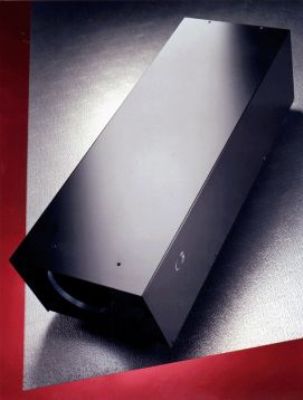Overview
Optical Surfaces Ltd. have collaborated with the Remote Sensing Group at the Defence Evaluation and Research Agency (D.E.R.A., Malvern, England) and the Civil Engineering Department of Salford University (Manchester, England) to develop high performance off-axis beam expanders for integration into a new generation of pulsed coherent LIDAR systems.

New Generation LIDAR System
The new generation LIDAR system was developed to measure phenomena involved in local wind fields and the dispersion of atmospheric pollution in built up city areas. In this demanding application the LIDAR directs an eye-safe pulsed CO2 laser into the atmosphere. Naturally occurring aerosol particles in the air backscatter the laser radiation and this is detected by the LIDAR receiver. The Doppler shift between the out-going and backscattered light is evaluated thereby giving the line-of-sight velocity of the aerosol scatterers which can be assumed to move with the localised wind field. The DERA site at Malvern has been involved in the development and theoretical understanding of remote sensing applications for over 30 years. With a considerable in-house expertise in theoretical physics and engineering staff familiar with building instruments, DERA have been involved in notable remote sensing projects with the UK MOD, European Space Agency, Aerospace Companies and University Research Departments. The task of having to try to measure the dispersion of airborne pollutants in a built up city environment along a clear air corridor necessitated the development of the new generation of pulsed coherent laser radar (LIDAR) system. Traditional techniques including radar and continuous wave (c.w) LIDAR were found to have notable shortfalls in trying to solve this problem. Whilst c.w LIDAR offered good spatial and spectral resolution, such systems typically measure wind velocity and turbulence at a point in space and are limited to a few hundred metres detection range. Radar was eliminated as a measurement tool mainly due to the clutter experienced close to a built up environment and the lack of clear air returns. The development of a pulsed coherent LIDAR system potentially was theorised to offer clear air detection over a distributed corridor to several kilometres range and not suffer from terrain induced clutter. The DERA design was based upon being able to build a compact and high performance monostatic system in which the same LIDAR telescope transmits and receives the laser signal.
Use of the Off-Axis Parabolic Beam Expander
Drawing upon 40 years of international design and manufacturing experience Optical Surfaces Ltd. indicated that the required high performance and design compactness was best achieved through an off-axis parabolic beam expander. Benefiting from a stabilised manufacturing environment Optical Surfaces was able to supply a compact x15 off-axis beam expander unit with a transmitted wavefront accuracy of lambda/5 over the complete 150mm output aperture measured at 633nm. The high surface quality of the optics virtually eliminated any limitation on the performance of the LIDAR system due to telescope feedback.Coming ready aligned the DERA team was able to simply and rapidly integrate the variable focus (infinity to 20 metres) beam expander into the LIDAR unit. Further future operational flexibility was built-in as the off-axis beam expander design gave completely achromatic performance from the infrared to the visible.
The DERA LIDAR System
Operating at 120 pulses per second (500 nanosecond pulse length) the DERA LIDAR system has been able to routinely measure the wind velocity and the aerosol concentration to a range of 3 km with a range resolution of approximately 100 meters. In future it is planned to exploit the achromatic performance of the optical system, making multiple wavelength DIfferential Absorption Lidar (D.I.A.L.) measurements in this Doppler mode where species concentrations and the wind field can be simultaneously monitored with the same equipment.
About Optical Surfaces Ltd.
Optical Surfaces Ltd., has been producing optical components and systems for more than 30 years and is now accepted as one of Europe's leading manufacturers of high-precision optics.
The main workshops and test facilities are deep underground in a series of tunnels excavated in solid chalk where temperature remains constant and vibration is practically non-existent.
With such stable conditions testing particularly with long path lengths become quantifiable and reliable. Working with these natural advantages is a highly skilled team of craftsmen with a commitment to excellence in both product quality and customer service.